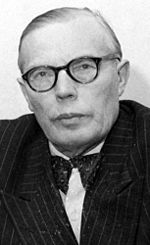Hannes Tiainen
Hannes Tiainen (born February 9, 1914 in Sortavala , Karelia , † April 8, 2001 in Helsinki ) was a Finnish politician of the Social Democratic Party SDP (Suomen Sosialidemokraattinen Puolue) , who campaigned in particular for the interests of small farmers . After a party dispute in the 1950s, he moved to the Social Democratic Union of Workers and Small Farmers TPSL in 1959 ( Työvänen ja Pienviljeliäin Sosialidemokraattinen Liitto) .
Life
Studies, cooperative functionary and deputy minister
Hannes Tiainen, son of the tailor Juho Tiainen and his wife Anna Sihvonen, began studying economics after attending school in 1932 and graduated in 1937 with a bachelor's degree in agriculture and forestry. He then worked for the Association of Consumer Cooperatives KK (Kulutusosuuskuntien Keskusliitto) in 1938 and worked in the agricultural department of the cooperative in Wiipuri between 1942 and 1943 and then head of the cooperative in East Karelia from 1943 to 1944. He then worked for a cooperative in south-west Finland, before returning to the KK in 1945 as head of the sales department for agricultural products. At the KK he was responsible for buying and selling agricultural products. In 1947 he was appointed head of the Association of Consumer Cooperatives KK.
He joined the Social Democratic Party of SDP (Suomen Sosialidemokraattinen Puolue) in 1947 and was one of the co-authors of the SDP's agricultural program, which was adopted in 1949. As an advisor to Prime Minister Karl-August Fagerholm , he was one of the leading agricultural politicians in the SDP, which called for a change of direction in agricultural policy. He set himself the goal of achieving a balance in agricultural production without reducing individual production. That would have meant a reduction in the number of farms. He believed that contract production would guarantee farmers a secure income. He belonged to the smallholder wing of the party, which lost importance in the SDP in the 1950s when the trade union movement gained importance. He supported Emil Skog as party leader. In the 1950s he became the leading agricultural expert of the SDP and wrote numerous, albeit controversial, articles on agricultural topics. During Penna Tervo's tenure as editor-in-chief, he wrote regularly for the party newspaper Suomen Sosialidemokraatti and in 1952 became a deputy member of the SDP board of directors. In accordance with the tradition of the old labor movement , he supported the "sobriety movement". Although he campaigned for the issue of smallholders in the SDP, he nevertheless tried to reach an agreement between wage earners and farmers within the party. He also campaigned for Karelian interests.
On December 3, 1952, he became Deputy Minister of Agriculture (Ministeri maatalousministeriössä) in the Kekkonen III cabinet and held this position until July 9, 1953. He also held the post of Deputy Minister of Agriculture from May 5 to October 20, 1954 in the Törngren cabinet . In the Kekkonen V cabinet that followed , he acted from October 20, 1954 to March 3, 1956 as Deputy Minister of Transport and Infrastructure (Ministeri kulkulaitosten ja ybaren töiden ministeriössä) and also as Deputy Minister from October 22, 1954 to March 3, 1956 Minister of Social Affairs (Ministeri sosiaaliministeriössä) . He then took over in the Fagerholm II cabinet between March 3, 1956 and May 27, 1957 again as Deputy Minister of Transport and Infrastructure and again as Deputy Minister of Social Affairs from March 5, 1956 to May 27, 1957. During the general strike in 1956 he was a member of the unofficial "strike committee", which included members of the trade union movement and the government. They met regularly and sought social peace.
Exclusion from the SDP and co-founder of the TPSL

After that, Hannes Tiainen was the General Director of the State Procurement Center (Valtion hankintakeskus) between 1957 and 1971 . During the split in the party in the late 1950s, he first tried to stay out of controversy. However, he soon joined the party opposition , which as Group 94 remained in the minority at the 1957 party congress. In 1959 he was a co-founder of the Social Democratic Federation of Workers and Small Farmers TPSL ( Työvänen ja Pienviljeliäin Sosialidemokraattinen Liitto) after the SDP had excluded supporters of the opposition from the party. He was a member of the party committee and vice chairman of the TPSL. He also acted as chairman of the TPSL in Helsinki and editor-in-chief of the party newspaper Päivä Sanomat , whose political orientation he decisively shaped. He also led the campaign for TPSL candidate Emil Skog in the 1962 presidential election .
In 1966 Hannes Tiainen left the TPSL and rejoined the SDP. He contributed to the political transformation of Väinö Leskinen in the 1960s and to changing the position of the SDP in relation to the Soviet Union . He visited the Soviet Union to take care of both party and state affairs. He was also in contact with representatives of the Soviet embassy. Most recently he was head of the production department of the National Office for Agriculture (Maatilahallitus) from 1971 to 1977 . His marriage to Esther Tuomainen in 1939 resulted in the children Jyrki, Sisko-Marja and Pirjo-Riitta.
Publications
- Kun puolue räjähti. Raportti sosiaalidemokraattisen työvänenliikkeen hajaannuksesta ja eheytymisesta , 1968
- Voivuoren vartijat , 1970
- Maaseudun asuttuna säilymisen edellytykset , 1979
- Palstaviljely ja sen kansantaloudellinen merkitys , 1983
Web links
- Entry in Valtioneuvosto
- Entry in Kansallisbiografia
- Kuka kukin on (Aikalaiskirja) ( Who's who in Finland , 1978)
Individual evidence
| personal data | |
|---|---|
| SURNAME | Tiainen, Hannes |
| BRIEF DESCRIPTION | Finnish politician |
| DATE OF BIRTH | February 9, 1914 |
| PLACE OF BIRTH | Sortavala , Karelia |
| DATE OF DEATH | April 8, 2001 |
| Place of death | Helsinki |